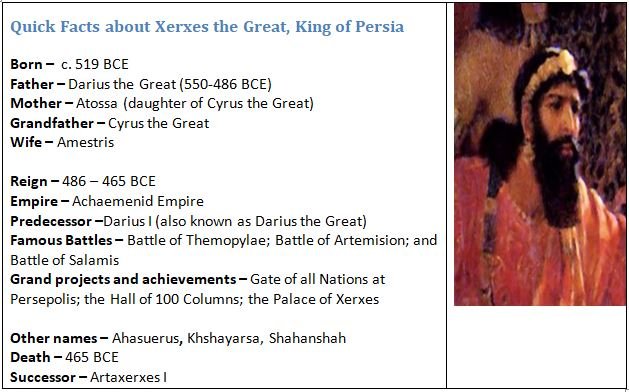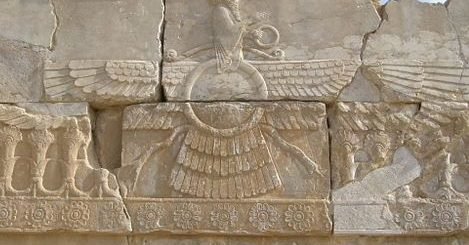Xerxes the Great, King of Persia: Biography & Achievements

Facts and Achievements of Xerxes the Great
From a typical Western history perspective, Xerxes I comes off as the bad guy whose sole goal was to bring ancient Greeks to their knees and wipe out every trace of democracy from their society. However, this is just one angle of looking at Xerxes I, also known as Xerxes the Great. In order to fully grasp the conflict between ancient Greeks and the Persians, a quick delve into who Xerxes the Great was is needed. Below is an exploration of the life, achievements, and the death of Xerxes the Great – the Persian king of kings:
Historians estimate that Xerxes I was born 519 BCE to a very influential Persian family that could boast of Cyrus the Great – founder of the Achaemenid Empire. Xerxes’ real name was actually Kysayarsa (Persian name). Cyrus was believed to be his maternal grandfather. Xerxes’ father was Darius the Great – the Persian king who started the war against Athens around 490 BCE.
Xerxes’ Rise to the throne
After the death of Darius I, Xerxes inherited the Persian throne around 486 BCE. It must be noted that Xerxes was not the eldest child of Darius the Great. He was however the first child of his mother, Atossa. His claim to the throne was challenged by his older half-brother Artabazenes who was the son of a commoner. In the end, however, the Persian throne passed on to Xerxes because his mother was the daughter of Cyrus the Great.
In his first few years as emperor, Xerxes tasked his Persian army (arguably the largest army at the time), to bring an end to uprisings that had lit up in several places in the empire, particularly in Egypt and Babylon.
Unlike his predecessors, Cyrus the Great and Darius the Great, Xerxes did not go easy on those revolts; instead, he made sure that he fiercely resisted and eliminated anyone that threatened to break up the empire. While quelling the resistance in Babylon, Xerxes deployed brutal means. He even antagonized the Babylonians by melting the statues of their gods and deities. From then onwards, no one dared rebel against Xerxes.
How large was Xerxes the Great’s Army?
Xerxes army was large enough to keep order at all cost throughout the Achaemenid Empire. It is believed that he was particularly careful in choosing his generals, making sure that they came from all over the empire.
The famous Greek historian Herodotus once estimated that Xerxes had combined army strength of about 2 million men. The historian also claimed that Xerxes had in his possession 4-5 thousand ships. Although these figures were somewhat embellished by Herodotus, Xerxes’ Persian army and military capabilities were still very much an enormous force to reckon with; regardless, he undoubtedly possessed the largest army in the world at the time.
Xerxes’ Military Campaigns in Greece
Leading Xerxes’ Persian army was his cousin (and brother-in-law), Mardonius. Owing to the advisement of Mardonius, Xerxes sought to resume his father’s military campaign against the Greeks.
He hoped to elevate the Persian Empire to heights his father, Darius, failed at doing. Xerxes tasked Mardonius to ready the army and set course for Greece. His goal was to bring famous city-states such as Sparta and Athens under his control. He hoped to capitalize on the disjointed nature of relationship among the Greek city-states.
A number of prophesies foretold of unimaginable sufferings to befall Xerxes and his empire should he go ahead with his plan of attacking Greece. One such bad omen to befall the king was when a horse allegedly gave birth to a hare. His uncle and adviser, Artabanus, even warned against attacking the Greeks. Regardless of this, Xerxes proceeded to attack, making his way across Hellespont into Europe.
As he crossed into Greece, the emperor experienced slight difficulties at sea. A few advisors and men in his camp started believing that it was the manifestation of the bad omen foretold by Xerxes’ priests. To calm the Hellespont, Xerxes is believed to have asked his men to literally beat the sea with canes 300 times. He also believed that he could literally restrain the sea by sinking metal shackles into it.
The Battles of Artemisium and Thermopylae
Anticipating the marching army of the Persians, the Greeks rallied together and formed a coalition of defense made up of a number of city-states. Leading the defense was Athens.
The Spartan king Leonidas marched solo with a group of a few thousands of soldiers to meet Xerxes head on. Although, Leonidas and his men fought bravely, their army was no match for the vast Persian army. Xerxes would go on to taste victory at the Battle of Artemisium (480 BCE), which was on his way to Athens.
Upon arriving in Athens, the furious Xerxes went ahead to burn down and ransack the city to the ground. The king was angry because the Athenians had the nerve to resist him and not bow to him.
Read More: 12 Greatest Ancient Military Commanders
Defeat at the Battle of Salamis
After winning the battles of Artemissium and Themopylae in 480 BCE, Xerxes believed that he had wind in his sails. He dived straight into the Battle of Salamis in late 480 BCE.
The Greek coalition of city states assembled their armies at Aegina and readied themselves to fight tooth and nail against the Persians. The Greeks were led by Themistocles.
Xerxes had the option to either proceed to Salamis or return home having inflicted a lot of destruction and ache upon Athens. Heeding the advice of Mardonius, Xerxes chose the former and battled the Greeks off the coast of Aegina.
This time around the Greeks were adequately prepared; they dished out an overwhelming defeat to Xerxes and his men at the Battle of Salamis.
Worn out and tired, Xerxes asked Mardonius to fight in his stead and lead the Persian army. Shortly after that, the Persian king packed up and headed home while Mardonius engaged the Greeks.
In the end the Greeks wiped out all of Mardonius’ men, killing the general in the process as well. En route home, Xerxes’ vastly depleted and exhausted army was further hit by fatigue and diseases.
Major Achievements of Xerxes the Great
With all hopes of ever conquering Greece dashed and scattered by the depletion of his army, Xerxes turned his attention to a different conquest. He used whatever resources that were left in his empire to sort of build the social and economic lives of his people.
King Xerxes rolled out a series of construction projects such as magnificent temples, palaces, statues and roads. Many of these projects were used to somewhat repair his image among his people. All of those projects came at huge cost to the Persian treasury. This necessitated the imposition of new taxes on the people. His mismanagement of an empire that had just been defeated left some sections of his people furious.
Decline of Xerxes’ rule
In his later years on throne, Xerxes developed a very lavish lifestyle that his treasury could not afford. He also took in several concubines and mistresses into his palace. It is even believed that he incurred the wrath of many of his advisers by incessantly going after the wife of his brother. Unable to get his brother’s wife, Xerxes went after the daughter of his brother, Artaynte, who willingly accepted the king’s proposal.
However, when Xerxes’ wife Amestris got news of her husband’s infidelity with Artaynte, she sent for Artaynte’s mother and mutilated her body. The death of his wife devastated Xerxes’ brother, Masistes. The king’s brother went ahead to fan a rebellion in one of the empire’s provinces, hoping to topple Xerxes. In the end, Xerxes put down the rebellion and sentenced his brother to death.
This and many more other events had a significant damage on Xerxes’ rule during his later years, ushering in the decline of his rule, as well as the Achaemenid Empire..
How did Xerxes the Great die?
Owing to the fact that Xerxes’ behavior had resulted in several close men of his either aggrieved or executed, the king became a bit unpopular in some circles of the Persian Empire.
During the construction of one of his magnificent projects, Xerxes was assassinated by one of his counselors, Artabanus. The assassin also took out Xerxes’ son, Darius. A different son of Xerxes, Artaxerxes I, rose up and avenged the deaths of his father and brother. Artaxerxes killed Artabanus and inherited the Persian throne.
Major Facts about Xerxes I

Facts and Achievement about Xerxes the Great
- Xerxes’ chief wife was Princess Amestris – daughter of Otanes. The marriage brought forth children such as Hystaspes, Darius, Achamenes, Amytis and Rhodogune.
- In a sacrilegious move, Xerxes is believed to have burnt down a famous statue of Marduk – the patron god of the city of Babylon. By so doing, Xerxes shook up the established relationship with the Babylonians, as well as host of other semi-autonomous city states in and around the Persian Empire.
- The reason why Xerxes’ father Darius began the war against Greece was because the Greeks supported the Ionian colonies in revolting against Achaemenid rule. The Persian army proved to be acutely inadequate in overrunning the Greeks at the Battle of Marathon in 490 BCE. Four years later, old and battle weary, Darius the Great died. The crown passed on to Xerxes.
- Historians reason that Xerxes’ second-in-command, Mardonius, convinced Xerxes to resume attacks against Greece because he, Mardonius, harbored dreams of ruling a very important satrapy (province). Mardonius also pressured Xerxes into taking a harder stance against the Babylonians – a Mesopotamian region that his grandfather Cyrus was quite warm to.
- Throughout Xerxes’ reign, the city of Babylon revolted at least twice. In all cases, Xerxes was unforgiving and ruthless, crushing the revolt with the full might of his army in 485 BCE.
- During his reign, Xerxes’ official title was Shahanshah. The word translates into “king of kings”.
- In the Bible (the Book of Esther), Xerxes was called Ahaseurus of Persia.
- From a Western historical perspective, he is called Xerxes; however, in the East, he was called Khshayarsa or Khshayarsha.
- After completely ruining Athens, Xerxes would have regrets years later. Such was the devastation caused by his Persian army.



























